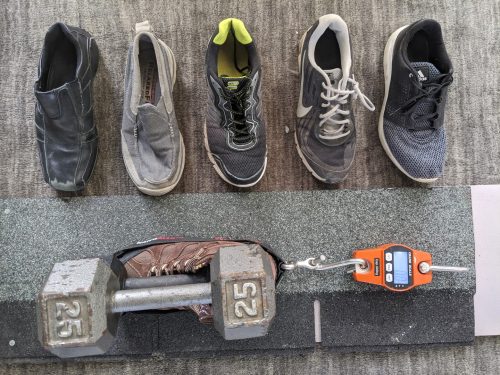Walking a wet asphalt shingle roof isn’t any more dangerous than walking a dry roof, provided it’s clean. Yep, you read that right. I said it.
Of course, there’s a bit of risk involved with walking any roof, but the added risk caused by walking a wet asphalt shingle roof is way overblown. I’ve been walking these roofs wet or dry for as long as I’ve been doing home inspections, and I’ve never found wet asphalt shingle roofs to be any less safe than a dry roof.
Again, I’m talking about clean roofs. All bets are off when the roof is dirty. If the roof is covered with things like moss, algae, leaves, or pine needles, it’s definitely less safe to walk when dry, but especially when wet.
But that’s just anecdotal. Me not falling off a wet roof does not a point make.
Grip Testing
To demonstrate this, I did some testing with wet and dry shingles. I took a new 3-tab asphalt shingle and tested the gription (not a real word) of several different shoes on both a wet surface and a dry surface. I used a digital crane scale to pull on the shoes with 40 pounds of weight applied downward.

I wanted to use more weight, but it was too tough for me to gently pull on the scale with more weight applied. I tested several different shoes; Cougar Paws (of course), Slip-Resistant Sketchers Work shoes, casual Sketchers shoes, and some old Nike, Adidas, and Fila shoes.
I first tested with dry shoes and recorded the maximum amount of weight that I could get with each set of shoes. I then soaked the shingle with a wet towel for 10 minutes and repeated the test. In each case, the wet and dry readings were nearly identical.
There are surely a thousand other types of shoes that I could have tested, but the results would surely remain the same.
For the record, the Cougar Paws and Slip-Resistant Sketchers work shoes were the top performers, with nearly identical results. I was quite surprised by this, as I was expecting the Cougar Paws to beat the pants off of everything else.
Here’s a video showing the tests:
Bottom Line
Clean, wet asphalt shingles aren’t any less safe to walk than dry ones. This does not apply to frost-covered roof, icy roofs, wood roofs, or any other type of roofing material. Wet wood roofs are ridiculously unsafe to walk, even with a mild slope.


Russ
January 21, 2020, 10:51 am
This is some pretty nerdy Inspection content and I love it! Thanks for taking the time to do this. In the Pacific Northwest, virtually every roof has some moss growth so wet roofs tend to be more risky.
Reuben Saltzman
January 21, 2020, 10:55 am
Thank you for reading, Russ!
Chris
January 21, 2020, 5:56 pm
Wet metal ladder is dangerous though.
Thomas Glynn
January 21, 2020, 7:16 pm
Hello Ruben,
I am a fan and regular reader. Thank you for your comprehensive testing and Shoe review.
I am happy to hear about your results – I always wear Sketchers when I walk on the roofs that I inspect. Sometimes, when they are low sloped or I forget to put the slip resistant work shoes in the car, I wear the casual style, notso-slip resistant Sketchers…
I have however slipped on concrete tile roofs and can confirm that this is not such a good idea. Out of curiosity – Do you have test results for this type of Sketcher shoe?
– I have conducted about 10,000 roof inspections in Florida and can confirm we do not have Moss on roofs here as they generally blow away Before they are in a condition to support the growth of the moss.
I have done my own Wet roof field testing and Shoe review & I find the same to be True for concrete tile covered roofs… There is really not much difference walking on them when they are wet or dry.
Clay Roof tiles are another story and Past Results Have indicated it would be Less destructive to walk on graham crackers.
Thank you again for all of your articles and hard work.
Thomas M Glynn PE
Rick
January 24, 2020, 6:02 am
Thanks for the heads up. Good observation that we need to be extra careful while working on those icy roofs. Thanks for the detailed and thorough report.
Paul Barraza
January 28, 2020, 5:42 pm
I can’t argue with your test, but as someone who walk roofs for a living (like you), I think you should point out that older shingles (not totally worn out) are more dangerous when they are wet.
Here is m my reasoning: The loose granules don’t fall to the gutter on wet roofs, they stick to your sole – creating a ball bearing effect.
That said, I still make every effort to walk every roof, too much important stuff to see up there.